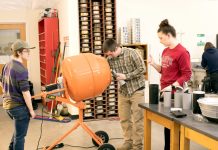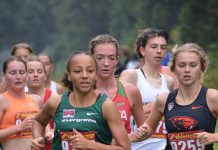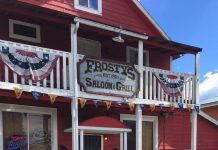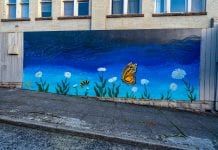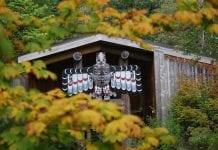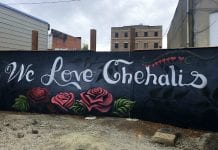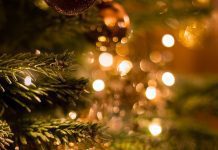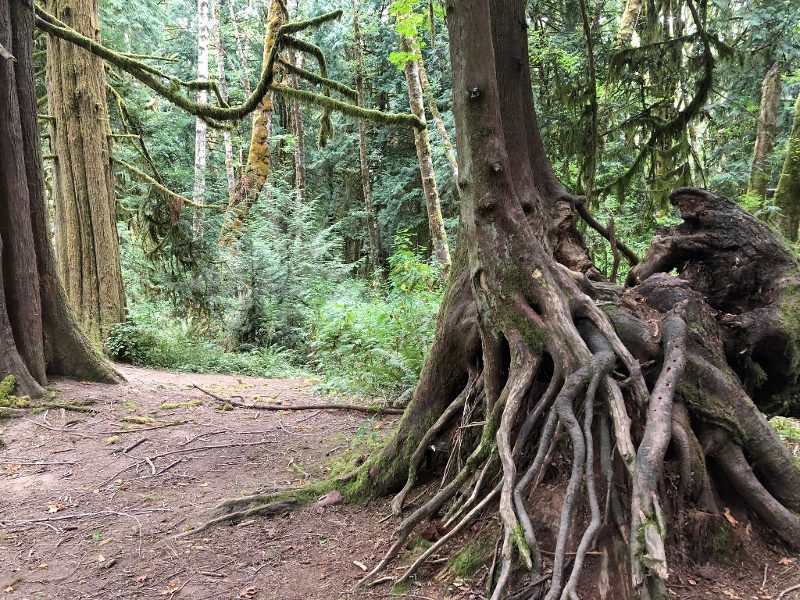The Pacific Northwest soil offers an abundance of plant varieties, thanks in part to a geologic history that includes at least four major glaciations. And you can observe and learn more about many of those woodland and forest plants while exploring The Evergreen State College’s scenic paths and gardens on its campus in Olympia.
Glacial Activity Created Soil Diversity Supporting Plants at The Evergreen State College
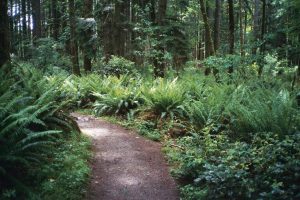
As every farmer and gardener knows, good plants start with good soil.
“The campus of The Evergreen State College is located on an area of low relief in the Puget Sound lowlands on the shores of Eld Inlet in Thurston County, Washington,” wrote Pene Speaks in a 1982 paper titled “The Campus of the Evergreen State College: Soils and Vegetation.” During glacial periods the campus was covered by ice, with the last glacier retreating about 15,000 years ago. “This glacial action plus subsequent erosion has left behind a mosaic of elements, from lacustrine (lake) silt and clay to glacial outwash of sand, gravel and till,” Speaks added. “These are the raw materials which have weathered into the soils now found in the area.”
The estimated 13 soil types on the 1,000-acre campus laid a fertile ground for the variety of plants you can see today. They include both naturally occurring vegetation as well as in plants added over the years by the college and its students.
Many Plant Varieties at The Evergreen State College
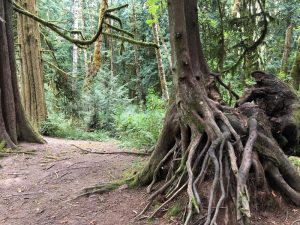
Walking around the campus gives you a chance to observe the extensive plant varieties along the sidewalks and paths, around buildings, in green spaces and in gardens.
Speaks wrote that the dominant vegetation form on campus is forest, which includes conifers, hardwoods, shrubs and ground covers. Sam Lohmann summarized the school’s plant communities in his 2006 paper, “A Floristic Study of The Evergreen State College Campus.” Lohmann wrote that the campus vegetation types include:
- “Woodland” with plant communities such as red alder and big-leaf maple.
- “Forest,” which includes Douglas fir and western red cedar.
- “Wetlands and riparian vegetation,” which includes salmonberry and Lyngbye’s sedge.
- “Scrub,” which includes willows.
- “Grasslands and other herbaceous vegetation,” which includes non-native perennial grasslands.

The “Welcome Woman” carving at the entrance to The Evergreen State College in Olympia invites you to explore the diverse woodland and forest plants on the campus. Photo credit: Nancy Krier
You do not need to be a plant expert to enjoy the campus flora. The college helps you identify the local varieties with labels placed at the base of many plants, particularly those located by the buildings surrounding the Red Square near the “Welcome Woman’’ carving at the college entrance. Those labels name vegetation such as wild rose, big leaf maples, sword ferns, common horsetail, red currant, ocean spray, California hazelnut, vine maples and mock orange, to list just a few.
And the college offers multiple nearby trails for you to enjoy the school’s lush forest setting and plant life as you walk, hike or run on those paths.
Teaching Gardens at the Evergreen State College
And there’s more. The college provides “public places to learn from plants” in its several teaching gardens scattered throughout the campus. The gardens foster environmental and cultural education, and many were designed by students.
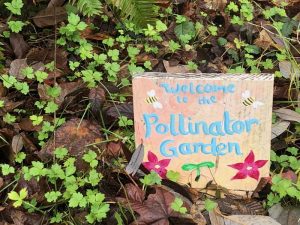
While most of the gardens’ plants are dormant in the winter months, mark your calendar to view them when they jump back to life in the spring and summer. The College’s website blog describes that the teaching gardens include:
- Basket Garden. “This garden will, in time, provide basket-making materials.”
- Laurasian Landscape. “North American and Eurasian plant relatives separated by continental drift and submersion of former land bridges.”
- Longhouse Ethnobotanical Garden. “Named ‘s’ulex’ by Upper Skagit elder, Vi Hilbert, this garden refers to gathering and creating possibilities from what nature offers.”
- Medicinal Herb Garden. “A European ethnobotanical garden on the Organic Farm with a Persian design common during the Renaissance.”
- Native Plant Demonstration Gardens. “Demonstrations of beautiful native plants that reduce the use of water, pesticides, and fertilizers.”
- Post-Glacial Forest. “A recreation of vegetation as the Vashon glacier receded from its terminus south of Olympia based on pollen core samples ranging in age from 14,000 to 8,000 years old.”
- Prairie Roof Garden. “Indigenous food plants and native medicine plants from local prairies.”
- Primitive Plant Garden. “Adaptive relatives of plants that appear earliest in the fossil records, such as ferns.”
- Rain Roof Gardens. “Impervious surfaces reduction. Unused rainwater drains to the ground nearby, recharging groundwater on site. The gardens also reduce energy use by insulating the roof.”
- Waterwise Pollinator Garden. “Drought tolerant plants that attract butterflies, hummingbirds, and bees.”
Getting to The Evergreen State College Campus
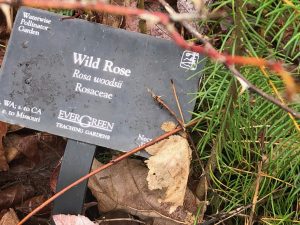
The Evergreen State College makes it easy to explore the large variety of plants at the main campus in Olympia, with driving directions here, maps to the trails here, and directions to the teaching gardens on this campus map. There is no charge to park on weekends or campus-observed holidays. Parking rates otherwise apply Monday through Friday.
Sponsored









